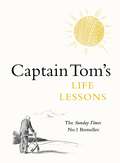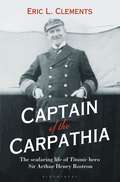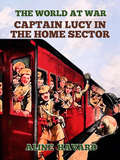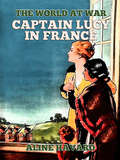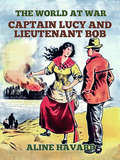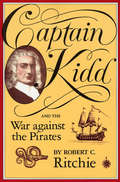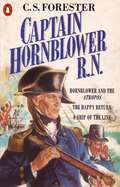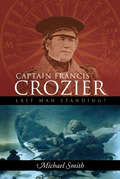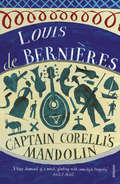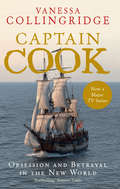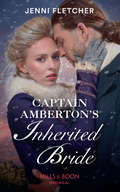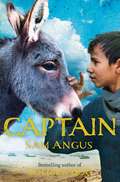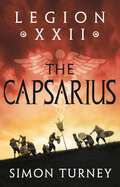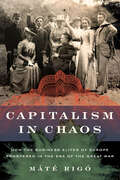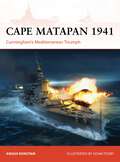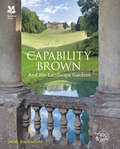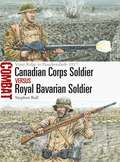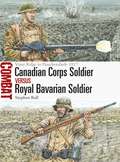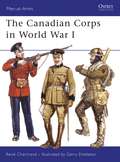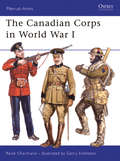- Table View
- List View
The Captains and the Kings: A Novel
by Jennifer JohnstonMr Prendergast, an elderly Anglo-Irishman, is living out his last years in the decaying splendour of his family mansion. As his mind wanders through the gloom he finds it peopled with memories of his neglected wife, his pale shadow of a father, his icily glamorous mother and Alexander, the son she so jealously loved, killed in the First World War. With only his ill-tempered alcoholic gardener left to attend to him, Mr Prendergast is content to pass his days in such ghostly company. Until young Diarmid arrives, keen-eyed and carrot-haired, to disperse the gathering darkness with curiosity, and the promise of friendship.
Captain Tom's Life Lessons
by Captain Tom MooreThe uplifting and heartwarming life lessons from a truly inspirational man, Captain Sir Tom Moore'One small soul like me won't make much difference' Captain Tom________If Captain Tom's big heart and generosity of spirit helped see us through difficult days, this was his parting gift.In Life Lessons, Captain Tom has shared all that he learned from living a full and vibrant life. With cherished anecdotes and his signature humour, these heartening life stories will teach you how to:· Be comfortable with who you are· Keep smiling through the tough times· Walk in someone else's shoes· Keep an open mind· Find your purposeFull of the wit, warmth and wisdom that made him so special, his reflections and guiding principles form a long life, well lived; Life Lessons will be a source of reassurance, hope, and encouragement for generations to come.And a reminder, whenever times are hard, that tomorrow will be a good day.________'Full of the infectious energy that inspired the nation' Daily MirrorPraise for Captain Sir Tom Moore:'A wonderful life story with lessons for us all . . . beautifully written' Daily Telegraph'Engaging . . . His upbeat nature shines through and reminds us how much worse this year would have been without him' Evening Standard'A great book' Good Morning Britain'A beautiful book. We have so much to learn from Captain Sir Tom' Chris Evans
Captain of the Carpathia: The seafaring life of Titanic hero Sir Arthur Henry Rostron
by Eric L. ClementsResponding to Titanic's distress calls in the early hours of 15 April 1912, Captain Arthur Rostron raced the Cunard liner Carpathia to the scene of the sinking, rescued the seven hundred survivors of the world's most famous shipwreck and then carried them to safety at New York. After twenty-five years at sea, the competence and compassion Rostron displayed during the rescue made him a hero on two continents and presaged his subsequent achievements.During the First World War he participated in the invasion of Gallipoli and commanded Cunard's Mauretania as a hospital ship in the Mediterranean and a troop transport in the Atlantic. As her longest-serving master he commanded that legendary vessel in transatlantic passenger service through most of the 1920s. Rostron retired in 1931 as the most esteemed master mariner of his era, celebrated for the Titanic rescue, decorated for his war service, and knighted for his contributions to British seafaring.This account uses newspaper reports, company records, government documents, contemporary publications and memoirs to recount Rostron's seafaring life from his first voyage as an apprentice rounding Cape Horn in sail to his retirement forty-four years later as commodore of the Cunard Line. Set within the context of his times and featuring particulars of the ships in which he served and commanded, this is the first comprehensive biography of Arthur Rostron before, during and after his year as captain of the Carpathia.
Captain of the Carpathia: The seafaring life of Titanic hero Sir Arthur Henry Rostron
by Eric L. ClementsResponding to Titanic's distress calls in the early hours of 15 April 1912, Captain Arthur Rostron raced the Cunard liner Carpathia to the scene of the sinking, rescued the seven hundred survivors of the world's most famous shipwreck and then carried them to safety at New York. After twenty-five years at sea, the competence and compassion Rostron displayed during the rescue made him a hero on two continents and presaged his subsequent achievements.During the First World War he participated in the invasion of Gallipoli and commanded Cunard's Mauretania as a hospital ship in the Mediterranean and a troop transport in the Atlantic. As her longest-serving master he commanded that legendary vessel in transatlantic passenger service through most of the 1920s. Rostron retired in 1931 as the most esteemed master mariner of his era, celebrated for the Titanic rescue, decorated for his war service, and knighted for his contributions to British seafaring.This account uses newspaper reports, company records, government documents, contemporary publications and memoirs to recount Rostron's seafaring life from his first voyage as an apprentice rounding Cape Horn in sail to his retirement forty-four years later as commodore of the Cunard Line. Set within the context of his times and featuring particulars of the ships in which he served and commanded, this is the first comprehensive biography of Arthur Rostron before, during and after his year as captain of the Carpathia.
Captain Lucy In The Home Sector (The World At War)
by Aline HavardExcerpt: "If the young people who read this last story of Lucy Gordon’s army life are disappointed that the end of the war does not bring her home to America they cannot possibly be as disappointed as she herself. She hoped that the war had really finished with the armistice but, like lots of us, she found that there was a great deal left to do that she had not counted upon. Peace was slow in coming, and the American army overseas had its hands as full trying to hasten it as all America on this side had, and still has, in trying to get back to peace-time ways. The tangle of affairs in war-swept Europe is more than Lucy can understand, though she sees a little of that great unrest, and catches a glimpse of its hidden dangers, even in the Home Sector. She does what she can to help, generously, and, though peace is not come and America is still distant, she and Bob and all the Gordon family find happiness together, and look forward with brave confidence to the glorious future of the dear country to which they will before long be homeward bound."
Captain Lucy in France (The World At War)
by Aline HavardExcerpt: "To those who made friends with Lucy Gordon on Governor’s Island it will seem a great change to find her, in this second story, so far away from home. She is only one of thousands, though, to whom a few months of the great war brought more changes than they ever thought could be crowded into a lifetime. Lucy can look back over less than a year to her old life at the army post in New York Harbor before the Colonel was ordered overseas. To that brief summer time when the Gordon family was united during her brother Bob’s West Point graduation leave, and to the dark days of the winter of 1917 when Bob was in a German prison. Even then Lucy never lost hope, and her brave confidence was gloriously rewarded with Bob’s freedom. But in those dreadful weeks of waiting she outgrew her childhood, as though even in that pleasant home on Governor’s Island she knew that peace and content could never come back to her and to those she loved until America had fired her final shot at Germany’s crumbling lines. She could not guess what lay before her,—what old friends she was to meet again in strange new places. Yet she had resolved, even before she had any hope of crossing to the other side, that, come what might, she would serve in her own way as steadfastly as her father served, as valiantly as Bob."
Captain Lucy and Lieutenant Bob (The World At War)
by Aline HavardExcerpt from Captain Lucy and Lieutenant Bob: The war is as yet only beginning for Lucy Gor don, and the old, pleasant times are just ending, but, like every other girl in America, she is trying hard to find the courage and cheerfulness which have never yet been wanting in our Service and which are going to help America to win.
Captain Kidd and the War against the Pirates
by Robert C. RitchieThe legends that die hardest are those of the romantic outlaw, and those of swashbuckling pirates are surely among the most durable. Swift ships, snug inns, treasures buried by torchlight, palm-fringed beaches, fabulous riches, and, most of all, freedom from the mean life of the laboring man are the stuff of this tradition reinforced by many a novel and film. It is disconcerting to think of such dashing scoundrels as slaves to economic forces, but so they were—as Robert Ritchie demonstrates in this lively history of piracy. He focuses on the shadowy figure of William Kidd, whose career in the late seventeenth century swept him from the Caribbean to New York, to London, to the Indian Ocean before he ended in Newgate prison and on the gallows. Piracy in those days was encouraged by governments that could not afford to maintain a navy in peacetime. Kidd’s most famous voyage was sponsored by some of the most powerful men in England, and even though such patronage granted him extraordinary privileges, it tied him to the political fortunes of the mighty Whig leaders. When their influence waned, the opposition seized upon Kidd as a weapon. Previously sympathetic merchants and shipowners did an about-face too and joined the navy in hunting down Kidd and other pirates. By the early eighteenth century, pirates were on their way to becoming anachronisms. Ritchie’s wide-ranging research has probed this shift in the context of actual voyages, sea fights, and adventures ashore. What sort of men became pirates in the first place, and why did they choose such an occupation? What was life like aboard a pirate ship? How many pirates actually became wealthy? How were they governed? What large forces really caused their downfall? As the saga of the buccaneers unfolds, we see the impact of early modern life: social changes and Anglo-American politics, the English judicial system, colonial empires, rising capitalism, and the maturing bureaucratic state are all interwoven in the story. Best of all, Captain Kidd and the War against the Pirates is an epic of adventure on the high seas and a tale of back-room politics on land that captures the mind and the imagination.
Captain Hornblower R.N.: Hornblower and the 'Atropos', The Happy Return, A Ship of the Line (A Horatio Hornblower Tale of the Sea)
by C. S. Forester"Hornblower and the Atropos" skippering the flagship for Nelson's funeral on the Thames is not Hornblower's idea of thrilling action. But soon his orders come, and he sets sail for the Mediterranean in the Atropos. 'Battle, storm, shipwreck, disease - what were the chances that he would never come back again?' "The happy return" Hornblower sails the South American waters and comes face to face with a mad, messianic revolutionary in a novel that ripples with risk and gripping adventure. "a ship of the line" commando raids, hurricanes at sea, the glowering menace of Napoleon's onshore gun batteries - Hornblower must deal with them all as he sails his ship to the Spanish station. Throughout his escapades Forester remains gallant, resourceful and courageous - the embodiment of all the most vivid in a great naval tradition.
Captain Francis Crozier: Last Man Standing?
by Michael SmithIrishman Francis Crozier was a major figure in nineteenth-century polar exploration. His voyages with Parry, Ross and Franklin lifted the veil from the frozen wastes of the Arctic and Antarctic, paving the way for Amundsen, Scott and Shackleton. The Antarctic cape named after him was immortalised in Apsley Cherry-Garrard's The Worst Journey in the World. A failed romance drove him back to the ice one fatal last time with Franklin's North West Passage expedition in 1845. All 129 men perished. Crozier took command after Franklin's death and led the courageous battle to survive in the Arctic wilderness. In the bitter life-or-death struggle, which lasted for years, some even resorted to cannibalism. But, according to legend, Crozier was the last to die – the last man standing. • Also available: An Unsung Hero: Tom Crean
Captain Corelli's Mandolin
by Louis de Bernieres'A true diamond of a novel, glinting with comedy and tragedy' Daily MailIt is 1941 and Captain Antonio Corelli, a young Italian officer, is posted to the Greek island of Cephalonia as part of the occupying forces.At first, he is ostracised by the locals but over time he proves himself to be civilised, humorous – and a consummate musician. When Pelagia, the local doctor's daughter, finds her letters to her fiancé go unanswered, Antonio and Pelagia draw close and the working of the eternal triangle seems inevitable. But can this fragile love survive as a war of bestial savagery gets closer and the lines are drawn between invader and defender?'Louis de Bernières is in the direct line that runs through Dickens and Evelyn Waugh...he has only to look into his world, one senses, for it to rush into reality, colours and touch and taste' Evening Standard25TH ANNIVERSARY EDITION - WITH A NEW INTRODUCTION BY THE AUTHOR
Captain Cook: The Life, Death And Legacy Of History's Greatest Explorer (Lyons Press Series)
by Vanessa CollingridgeA uniquely woven story encompassing three separate centuries and three different lives. Captain Cook, best known for his heroic voyages through the Pacific Ocean, is brought to life in vivid detail. We follow his humble beginnings as the son of a farm labourer, through his convention-shattering treatment of the indigenous groups he met on his travels, and then onto his final tragic voyage which signalled the end of his revered reputation. One hundred years on from the death of Cook, another great man, George Collingridge begins his own adventure. He, like Cook was oblivious to the implications his journey would have. Along the way he unfolds ancient maps, secret tales and unearths hidden lands and buried treasure. He is also said to have realised that it was not Cook who discovered Australia - it was the Portugese. This firm belief was the eventual cause of his self-destruction.Another hundred years later Vanessa Collingridge, is searching for books on her lifelong hero Captain Cook in a university library. She discovers the name of a distant cousin, George Collingridge, in a dusty card index. And so a new journey of discovery begins - in the footsteps of her hero and his nemesis.
Captain Amberton's Inherited Bride: In The Sheriff's Protection In Thrall To The Enemy Commander Captain Amberton's Inherited Bride (Mills And Boon Historical Ser.)
by Jenni Fletcher‘Marry me… …And you’ll have your freedom.’
Captain: Marco Polo; Ibn Battuta; Christopher Columbus; Bartolomeu Diaz Vasco Da Gama; Ferdinand Magellan; Captain Cook Lewis And Clark; Livingstone And Stanley; The Apollo Mission
by Sam AngusIt's 1915 and British troops are about to sail to Gallipoli. Billy is the youngest soldier in his platoon and is teased for not being old enough to drink or shave. The truth is, at 15 he's not old enough to be a soldier either, and he's terrified of the war he's about to fight. Then he meets Captain, a refugee boy, and his donkey, Hey-ho. Together they teach Billy what it means to be brave, loyal and fearless, and above all what it means to be a friend.
The Capsarius (Legion XXII)
by Simon TurneyWarrior and combat medic, Titus Cervianus, must lead a legion and quell the uprisings in Egypt in this thrilling Roman adventure from Simon Turney. Titus Cervianus is no ordinary soldier. And the Twenty Second is no ordinary legion...Egypt. 25 BC. A former surgeon from the city of Ancyra, Titus Cervianus is now a capsarius – a combat medic. He is a pragmatist, a scientist – and deeply unpopular with his legion, the Twenty Second Deiotariana.The Twenty Second have been sent to deal with uprisings in Egypt. Founded as the private army of one of Rome's most devoted allies, their ways are not the same as the other legions', which sets them apart and causes friction with their fellow soldiers.Marching into the unknown, Cervianus will find unexpected allies: a local cavalryman and a troublesome lunatic. Both will be of critical importance as the young medic marches through the searing sands of the south, finding forbidden temples, hidden assassins, and worst of all, the warrior queen of Kush...Reviews for The Capsarius'Brings a whole new dimension to the genre... Recommended' Historical Novel Society'A blistering epic brimming with tension, mystery and adventure!' Gordon DohertyReviews for Simon Turney'A page turner from beginning to end... A damn fine read' Ben Kane'First-rate Roman fiction' Matthew Harffy
Capitalism in Chaos: How the Business Elites of Europe Prospered in the Era of the Great War
by Máté RigóCapitalism in Chaos explores an often-overlooked consequence and paradox of the First World War—the prosperity of business elites and bankers in service of the war effort during the destruction of capital and wealth by belligerent armies. This study of business life amid war and massive geopolitical changes follows industrialists and policymakers in Central Europe as the region became crucially important for German and subsequently French plans of economic and geopolitical expansion in the late nineteenth and early twentieth centuries. Based on extensive research in sixteen archives, five languages, and four states, Máté Rigó demonstrates that wartime destruction and the birth of "war millionaires" were two sides of the same coin. Despite the recent centenaries of the Great War and the Versailles peace treaties, knowledge of the overall impact of war and border changes on business life remains sporadic, based on scant statistics and misleading national foci. Consequently, most histories remain wedded to the viewpoint of national governments and commercial connections across national borders.Capitalism in Chaos changes the static historical perspective by presenting Europe's East as the economic engine of the continent. Rigó accomplishes this paradigm shift by focusing on both supranational regions—including East-Central and Western Europe—as well as the eastern and western peripheries of Central Europe, Alsace-Lorraine and Transylvania, from the 1870s until the 1920s. As a result, Capitalism in Chaos offers a concrete, lively history of economics during major world crises, with a contemporary consciousness toward inequality and disparity during a time of collapse.
Cape Matapan 1941: Cunningham’s Mediterranean Triumph (Campaign #397)
by Angus KonstamThe first ever illustrated study of the largest and most significant clash between the Royal Navy and the Italian Regia Marina.The Battle of Matapan witnessed the first use of decisive new technologies to bring about a stunning British victory over the Italian Navy. The Allies had tapped into the Ultra coded messages sent by the Axis powers, and the battle witnessed the use of radar and carrier-based air strikes to bring about a critical night action. The result was the most decisive engagement of the Mediterranean naval war.Written by renowned naval historian Angus Konstam, this book offers for the first time a unique and fully illustrated exploration of the battle. It also examines why, despite the emphatic and decisive Royal Navy victory, the Allies failed to capitalize on the strategic advantage earned in the months that followed. Battlescene artworks bring to life the cruiser clashes early on 28 March off Gavdos, the Fleet Air Arm attacks on the Italian fleet, and the 28/29 March night action that resulted in the destruction of Admiral Carlo Cattaneo's ships – Italy's worst naval defeat. The progress of the action from the initial Operation Gaudo sweep by Italy's powerful battle fleet towards Crete (aimed at disrupting Allied convoys) to the events of the climactic battle itself is revealed in detailed maps.
Cape Matapan 1941: Cunningham’s Mediterranean Triumph (Campaign #397)
by Angus KonstamThe first ever illustrated study of the largest and most significant clash between the Royal Navy and the Italian Regia Marina.The Battle of Matapan witnessed the first use of decisive new technologies to bring about a stunning British victory over the Italian Navy. The Allies had tapped into the Ultra coded messages sent by the Axis powers, and the battle witnessed the use of radar and carrier-based air strikes to bring about a critical night action. The result was the most decisive engagement of the Mediterranean naval war.Written by renowned naval historian Angus Konstam, this book offers for the first time a unique and fully illustrated exploration of the battle. It also examines why, despite the emphatic and decisive Royal Navy victory, the Allies failed to capitalize on the strategic advantage earned in the months that followed. Battlescene artworks bring to life the cruiser clashes early on 28 March off Gavdos, the Fleet Air Arm attacks on the Italian fleet, and the 28/29 March night action that resulted in the destruction of Admiral Carlo Cattaneo's ships – Italy's worst naval defeat. The progress of the action from the initial Operation Gaudo sweep by Italy's powerful battle fleet towards Crete (aimed at disrupting Allied convoys) to the events of the climactic battle itself is revealed in detailed maps.
Capability Brown: And His Landscape Gardens (National Trust History And Heritage Ser.)
by Sarah RutherfordOne of the most remarkable men of the 18th century, Lancelot ‘Capability’ Brown was known to many as ‘The Omnipotent Magician’ who could transform unpromising countryside into beautiful parks that seemed to be only the work of nature.
The Candle Factory Girl: A gritty story of deceit and betrayal... (Banbury Street #1)
by Tania Crosse1930's London - A backstreet saga full of hopes, dreams and the fight for survival. Perfect for the fans of Rosie Clarke and Lindsey Hutchinson. Work at Price's Candle Factory in Battersea is tedious for intelligent, seventeen-year-old Hillie Hardwick, but she knows she is lucky to have a job at all. Her home life is no better, as she constantly battles with her exacting and bullying father in order to protect her mother and five younger siblings from his abuse. Her only solace is her loving relationship with the chaotic Parker family and her best friend, Gert Parker. When matters violently escalate for Hillie, smitten Jack-the-Lad Jimmy Baxter seems her only salvation. But could this be the biggest mistake of her life, and should she be looking for protection nearer home? A story that crackles with unease where courage and friendship are the only hope. What readers are saying: 'This is a great saga that packs so much emotion and passion into it that you are swept away' Dash Fan Book Reviews. 'This is a wonderful saga... In my opinion, this is her best book yet. I have no hesitation whatsoever in recommending this one as a truly great read' Good 'N Ready. 'I really enjoyed this book, it has some great characters and I loved the setting!' Donna's Book Blog. 'For me it was a fast read, really well written storyline with characters you get invested in' Holly Senecal, NetGalley.
Canadian Corps Soldier vs Royal Bavarian Soldier: Vimy Ridge to Passchendaele 1917 (Combat)
by Adam Hook Stephen BullIn 1917 the soldiers of the Canadian Corps would prove themselves the equal of any fighting on the Western Front, while on the other side of the wire, the men of the Royal Bavarian Army won a distinguished reputation in combat. Employing the latest weapons and pioneering tactics, these two forces would clash in three notable encounters: the Canadian storming of Vimy Ridge, the back-and-forth engagement at Fresnoy and at the sodden, bloody battle of Passchendaele. Featuring carefully chosen archive photographs and specially commissioned artwork, this study assesses these three hard-fought battles in 1917 on the Western Front, and offers a new take on the evolving nature of infantry combat in World War I.
Canadian Corps Soldier vs Royal Bavarian Soldier: Vimy Ridge to Passchendaele 1917 (Combat)
by Adam Hook Stephen BullIn 1917 the soldiers of the Canadian Corps would prove themselves the equal of any fighting on the Western Front, while on the other side of the wire, the men of the Royal Bavarian Army won a distinguished reputation in combat. Employing the latest weapons and pioneering tactics, these two forces would clash in three notable encounters: the Canadian storming of Vimy Ridge, the back-and-forth engagement at Fresnoy and at the sodden, bloody battle of Passchendaele. Featuring carefully chosen archive photographs and specially commissioned artwork, this study assesses these three hard-fought battles in 1917 on the Western Front, and offers a new take on the evolving nature of infantry combat in World War I.
The Canadian Corps in World War I (Men-at-Arms)
by Gerry Embleton René ChartrandThis book describes the organization, lists the units and illustrates the uniforms and equipment of the four Canadian divisions which earned an elite reputation on the Western Front in 1915-18. Canada's 600,000 troops of whom more than 66,000 died and nearly 150,000 were wounded represented an extraordinary contribution to the British Empire's struggle. On grim battlefields from the Ypres Salient to the Somme, and from their stunning victory at Vimy Ridge to the final triumphant 'Hundred Days' advance of autumn 1918, Canada's soldiers proved themselves to be a remarkable army in their own right, founding a national tradition.
The Canadian Corps in World War I (Men-at-Arms)
by Gerry Embleton René ChartrandThis book describes the organization, lists the units and illustrates the uniforms and equipment of the four Canadian divisions which earned an elite reputation on the Western Front in 1915-18. Canada's 600,000 troops of whom more than 66,000 died and nearly 150,000 were wounded represented an extraordinary contribution to the British Empire's struggle. On grim battlefields from the Ypres Salient to the Somme, and from their stunning victory at Vimy Ridge to the final triumphant 'Hundred Days' advance of autumn 1918, Canada's soldiers proved themselves to be a remarkable army in their own right, founding a national tradition.
Can You Play Cricket on Mars?: And Other Scientific Questions Answered
by Sir Patrick MooreCan You Play Cricket on Mars? answers questions like: is there a dark side to the Moon? what happens when a comet hits the Sun? do the Martian canals have any water in them? is the Moon hot inside? what would happen if the Sun were to collide with a black hole? Mars has polar ice caps: could polar bears live there? if I could go back to the time of the dinosaurs, would the sky look the same as it does today? and many more.

